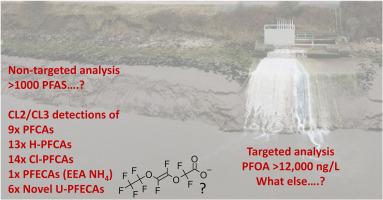非目标分析显示,英国一家氟化工厂附近的淡水中含有数百种全氟和多氟烷基物质 (PFAS)。
IF 8.1
2区 环境科学与生态学
Q1 ENVIRONMENTAL SCIENCES
引用次数: 0
摘要
目前,公认的全氟烷基和多氟烷基物质 (PFAS) 已超过 700 万种,但大多数常规监测计划和政策决策仅基于其中的少数几种。有必要转向更好地了解样本中存在的全氟辛烷磺酸总量,而不是仅仅依赖于有针对性的分析。全氟辛烷磺酸总量检测方法有助于我们了解目标检测方法是否遗漏了大量全氟辛烷磺酸,但并不能确定遗漏了哪些全氟辛烷磺酸。非靶向方法通过使用高分辨率质谱来确定样品中存在的 PFAS,从而填补了这一知识空白。在这篇手稿中,我们使用靶向分析和非靶向分析(NTA)相结合的方法检测了英国西北部五种淡水样本中的数百种 PFAS。定向分析发现,PFOA 的最大浓度为 12,100 纳克/升,比拟议的环境质量标准 (EQS) 100 纳克/升高出三个数量级。根据保守评估计算,所有样本中的 PFAS 总平均浓度约为 40 μg L-1。在置信度为 4 的情况下,可疑筛选方法确定了 1175 个(最不保守)到 89 个(最保守)PFAS。在这 43 种 PFAS 中,只有 8 种(占 PFAS 总峰面积的 17%)作为英国 DWI 47 PFAS 的一部分在英国进行定期监测。我们的研究结果表明,存在一组与全氟烷基醚羧酸 (PFECA) EEA-NH4 相关的新型不饱和全氟烷基醚羧酸 (U-PFECA),为非靶向筛选的优点提供了一个范例。这项研究强调了非目标方法的优点,并表明未来的监测计划和法规将受益于纳入非目标元素。本文章由计算机程序翻译,如有差异,请以英文原文为准。

Non-targeted analysis reveals hundreds of per- and polyfluoroalkyl substances (PFAS) in UK freshwater in the vicinity of a fluorochemical plant
There are now over 7 million recognised per- and polyfluoroalkyl substances (PFAS), however the majority of routine monitoring programmes and policy decisions are based on just a handful of these. There is need for a shift towards gaining a better understanding of the total PFAS present in a sample rather than relying on targeted analysis alone. Total PFAS methods help us to understand if targeted methods are missing a mass of PFAS, but they do not identify which PFAS are missing. Non-targeted methods fill this knowledge gap by using high resolution mass spectrometry to identify the PFAS present in a sample. In this manuscript we use complimentary targeted and non-targeted analysis (NTA) to detect hundreds of PFAS in five freshwater samples obtained from the Northwest of the UK. Targeted analysis revealed PFOA at a maximum concentration of 12,100 ng L−1, over three orders of magnitude greater than the proposed environmental quality standard (EQS) of 100 ng L−1. A conservative assessment calculated an average total PFAS concentration of approximately 40 μg L−1 across all samples. A suspect screening approach identified between 1175 (least conservative) to 89 (most conservative) PFAS at confidence level 4. Exploratory data analysis was used to identify 33 PFAS at confidence level 3 and 10 PFAS at a confidence level of 2. Only 8 of these 43 PFAS (representing 17% of the total PFAS peak area) are regularly monitored in the UK as part of the UK DWI 47 PFAS. Our results suggested the presence of a novel group of unsaturated perfluoroalkyl ether carboxylic acids (U-PFECAs) related to EEA-NH4, a perfluoroalkyl ether carboxylic acid (PFECA), providing an example of the benefits of non-targeted screening. This study highlights the merits of non-targeted methods and demonstrates that future monitoring programmes and regulations would benefit from incorporating a non-targeted element.
求助全文
通过发布文献求助,成功后即可免费获取论文全文。
去求助
来源期刊

Chemosphere
环境科学-环境科学
CiteScore
15.80
自引率
8.00%
发文量
4975
审稿时长
3.4 months
期刊介绍:
Chemosphere, being an international multidisciplinary journal, is dedicated to publishing original communications and review articles on chemicals in the environment. The scope covers a wide range of topics, including the identification, quantification, behavior, fate, toxicology, treatment, and remediation of chemicals in the bio-, hydro-, litho-, and atmosphere, ensuring the broad dissemination of research in this field.
 求助内容:
求助内容: 应助结果提醒方式:
应助结果提醒方式:


